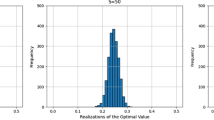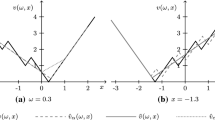Abstract
Multistage stochastic programs with interstage independent random parameters have recourse functions that do not depend on the state of the system. Decomposition-based algorithms can exploit this structure by sharing cuts (outer-linearizations of the recourse function) among different scenario subproblems at the same stage. The ability to share cuts is necessary in practical implementations of algorithms that incorporate Monte Carlo sampling within the decomposition scheme. In this paper, we provide methodology for sharing cuts in decomposition algorithms for stochastic programs that satisfy certain interstage dependency models. These techniques enable sampling-based algorithms to handle a richer class of multistage problems, and may also be used to accelerate the convergence of exact decomposition algorithms.
Similar content being viewed by others
References
J.R. Birge, “Decomposition and partitioning methods for multistage stochastic linear programs,”Operations Research 33 (1985) 989–1007.
J.R. Birge, C.J. Donohue, D.F. Holmes and O.G. Svintsitski, “A parallel implementation of the nested decomposition algorithm for multistage stochastic linear programs,” Technical Report 94-1, Department of Industrial and Operations Engineering, University of Michigan, Ann Arbor, MJ (1994).
J.R. Birge and F.V. Louveaux, “A multicut algorithm for two-stage stochastic linear programs,”European Journal of Operational Research 34 (1988) 384–392.
J.R. Birge and R.J.-B. Wets, “Sublinear upper bounds for stochastic programs with recourse,”Mathematical Programming 43 (1989) 131–149.
J.R. Birge and R.J.-B. Wets, “Designing approximation schemes for stochastic optimization problems, in particular, for stochastic programs with recourse,”Mathematical Programming Study 27 (1986) 54–102.
G.E.P. Box and G.M. Jenkins,Time Series Analysis: Forecasting and Control (Holden-Day, San Francisco, CA, revised ed., 1976).
G.B. Dantzig and P.W. Glynn, “Parallel processors for planning under uncertainty,”Annals of Operations Research 22 (1990) 1–21.
G.B. Dantzig and M. Madansky, “On the solution of two-staged linear programs under uncertainty,” in: J. Neyman, ed.,Proceedings of the 4th Berkeley Symposium on Mathematical Statistics and Probability 1 (University of California Press, Berkeley, CA, 1961) pp. 165–176.
N.C.P. Edirisinghe and W.T. Ziemba, “Tight bounds for stochastic convex programs,”Operations Research 40 (1992) 660–677.
Y. Ermoliev, “Stochastic quasigradient methods,” in: Y. Ermoliev and R.J.-B. Wets, eds.,Numerical Techniques for Stochastic Optimization (Springer, Berlin, 1988).
K. Frauendorfer,Stochastic Two-Stage Programming, Lecture Notes in Economics and Mathematical Systems, Vol. 392, (Springer, Berlin, 1992).
K. Frauendorfer, “Solving SLP recourse problems with arbitrary multivariate distributions— The dependent case,”Mathematics of Operations Research 13 (1988) 377–394.
H.I. Gassmann, “MSLiP: A computer code for the multistage stochastic linear programming problem,”Mathematical Programming 47 (1990) 407–423.
J.L. Higle and S. Sen, “Stochastic decomposition: An algorithm for two-stage linear programs with recourse,”Mathematics of Operations Research 16 (1991) 650–669.
G. Infanger,Planning under Uncertainty: Solving Large-scale Stochastic Linear Programs (The Scientific Press Series, Boyd & Fraser, New York, 1994).
G. Infanger, “Monte Carlo (importance) sampling within a Benders decomposition algorithm for stochastic linear programs,”Annals of Operations Research 39 (1992) 69–95.
P. Kall A. Ruszczyński and K. Frauendorfer, “Approximation techniques in stochastic programming,” in: Y. Ermoliev and R.J.-B. Wets, eds.,Numerical Techniques for Stochastic Optimization (Springer, Berlin, 1988).
D.P. Morton, “An enhanced decomposition algorithm for multistage stochastic hydroelectric scheduling,”Annals of Operations Research 64 (1996) 211–235.
M.V.F. Pereira and L.M.V.G. Pinto, “Multi-stage stochastic optimization applied to energy planning,”Mathematical Programming 52 (1991) 359–375.
M.V.F. Pereira and L.M.V.G. Pinto, “Stochastic optimization of a multi-reservoir hydroelectric System— A decomposition approach,”Water Resources Research 21 (1989) 779–792.
A. Ruszczyński, “A regularized decomposition method for minimizing a sum of polyhedral functions,”Mathematical Programming 35 (1986) 309–333.
G.C. Tiao and G.E.P. Box, “Modeling multiple time series with applications,”Journal of the American Statistical Association 76 (1981) 802–816.
R.S. Tsay and G.C. Tiao, “Consistent estimates of autoregressive parameters and extended sample autocorrelation function for stationary and nonstationary ARMA models,”Journal of the American Statistical Association 79 (1984) 84–96.
R.M. Van Slyke and R.J.-B. Wets, “L-shaped linear programs with applications to optimal control and stochastic programming,”SIAM Journal on Applied Mathematics 17 (1969) 638–663.
R.J.-B. Wets, “Large scale linear programming techniques”, in: Y. Ermoliev and R.J.-B. Wets, eds.Numerical Techniques for Stochastic Optimization (Springer, Berlin, 1988).
R.J.-B. Wets, “Stochastic programs with fixed recourse: The equivalent deterministic program,”SIAM Review 16 (1974) 309–339.
R.J. Wittrock “Advances in a nested decomposition algorithm for solving staircase linear programs,” Technical Report SOL 83-2, Systems Optimization Laboratory. Department of Operations Research, Stanford University, Stanford, CA (1983).
Author information
Authors and Affiliations
Corresponding author
Additional information
Research leading to this work was partially supported by the Department of Energy Contract DE-FG03-92ER25116-A002; the Office of Naval Research Contract N00014-89-J-1659; the National Science Foundation Grants ECS-8906260, DMS-8913089; and the Electric Power Research Institute Contract RP 8010-09, CSA-4O05335.
This author's work was supported in part by the National Research Council under a Research Associateship at the Naval Postgraduate School, Monterey, California.
Rights and permissions
About this article
Cite this article
Infanger, G., Morton, D.P. Cut sharing for multistage stochastic linear programs with interstage dependency. Mathematical Programming 75, 241–256 (1996). https://doi.org/10.1007/BF02592154
Received:
Revised:
Issue Date:
DOI: https://doi.org/10.1007/BF02592154




